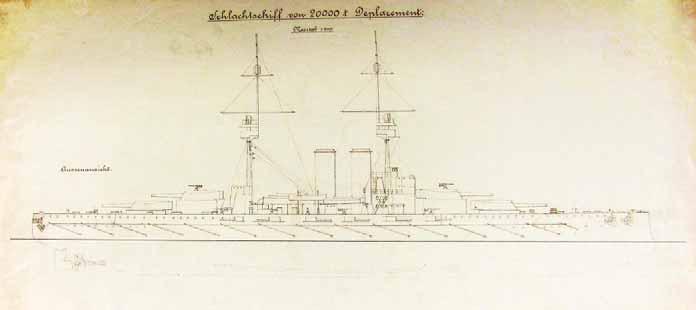bius and the quality of its ships. The Navy defended the yard in a letter to the Heir of the Throne, but he maintained his concerns.286 The construction process in the Hungarian yard was very slow compared to the STT. The keel of the Schlachtschiff VI (Prinz Eugen) was laid on 16 January 1912 in Trieste and she was launched on 30 November of the same year, so her construction time was ten and a half months. In the case of the Schlachtschiff VII this time was two years. Beside the lack of experience of the workers, strikes and great delays of the subcontractors, like Witkowitz, Schoeller and Wertheim, slowed the work on the ship. At the end of 1913, the ship was 60 percent complete. At this time, it was evident that the original delivery deadline could not be kept. The Bauleitung Bergudi (the board of the Navy which surveyed the works in the Danubius) proposed a new delivery deadline of 20 January 1915 instead of 10 July 1914.287 The Name Giving and the Launch Due to the slow construction of the Schlachtschiff VII it became obvious in the fall of 1913 that the launch would be delayed nearly a whole year from the originally planned date. As was mentioned previously, in Austria-Hungary the process to choose the name for a warship under construction usually began a few months prior to the launch and to choose the name was the Emperor’s right. In the years prior to the First World War the process was controlled by a regulation sanctioned by Franz Joseph in May 1898.288 Since 1908, the Navy sent its proposals to the Heir of the Throne, but even he had to approve his choice by the Emperor. Sometimes the Emperor exercised his right to choose a name on his own, for example in the case of the Schlachtschiff IV. Franz Ferdinand chose for this ship the name Tegetthoff but Franz Joseph told via his Military Chancellery that he named the ship after his personal motto Viribus Unitis. Choosing the name for the Hungarian built battleship was a delicate matter. The Hungarian government had expressed its wish a few years earlier, when the case of the name giving of the preceding battleships had been at issue, to give a Hungarian name to one of them. In 1911, the Navy proposed the name Hunyadi for the Hungarian built ship, but Franz Ferdinand did not deal with it. In April
1913, the Navy sent the following proposals to the Heir of the Throne: Corvin Mátyás, Szent István, Hunyadi and Erzsébet Királyné. Franz Ferdinand rejected Corvin Mátyás and Erzsébet Királyné on the ground that these names would fuel the Hungarian separatism, and he rejected Hunyadi stating that there were living relatives of that family. In fact, he wanted a name which symbolized the unity of the Empire: Laudon after the 18th century Austrian General Ernst Gideon Freiherr von Laudon. When he informed of his choice Admiral Anton Haus, the Marinekommandant could not sleep all night because he knew that naming a Hungarian-built ship after an Austrian General would create a scandal and turmoil in Hungary.289 At last the old Emperor saved the situation. General Arthur von Bolfras, the head of the Military Chancellery of the Emperor calmed Haus and the Hungarians by telling them that the Hungarian ship would have a Hungarian name. Bolfras personally backed the name Szent István and he convinced the Emperor. In June 1913, Franz Joseph chose the name Szent István for the Schlachtschiff VII.290 The question of the sponsor (Taufpatin) was another delicate matter. Franz Ferdinand originally wanted the wife of Leopold Berchtold, the common Foreign minister, but his style (“Inevitable that the sponsor should be a Hungarian Lady”) angered the Hungarians. Yet the Navy saved the situation declaring that the sponsor of a battleship could only be an archduchess of the Habsburg family.291 The first choice of Franz Ferdinand was Archduchess Zita, but her husband (the later Emperor Karl) rejected it because the archduchess was pregnant (with Archduchess Adelheid). Finally, Archduchess Maria Theresia, the stepmother of Franz Ferdinand, together with her daughter accepted the task. She was an experienced sponsor. Her daughter, Maria Annunziata called off her participation a few weeks before the launch, in which Haus saw of the hand of the Heir of the Throne. Franz Ferdinand called off his participation on the launch in November 1913 which angered Haus because he felt, that the Heir of the Throne discredited pre-eminently the Navy.292 In truth Franz Ferdinand was absent from the launch of the Prinz Eugen too, moreover, on that occasion he had banned the participation of large naval units, while on the launch of the Szent István, the dreadnoughts Viribus Unitis and Tegetthoff were present.
— 86 —






























